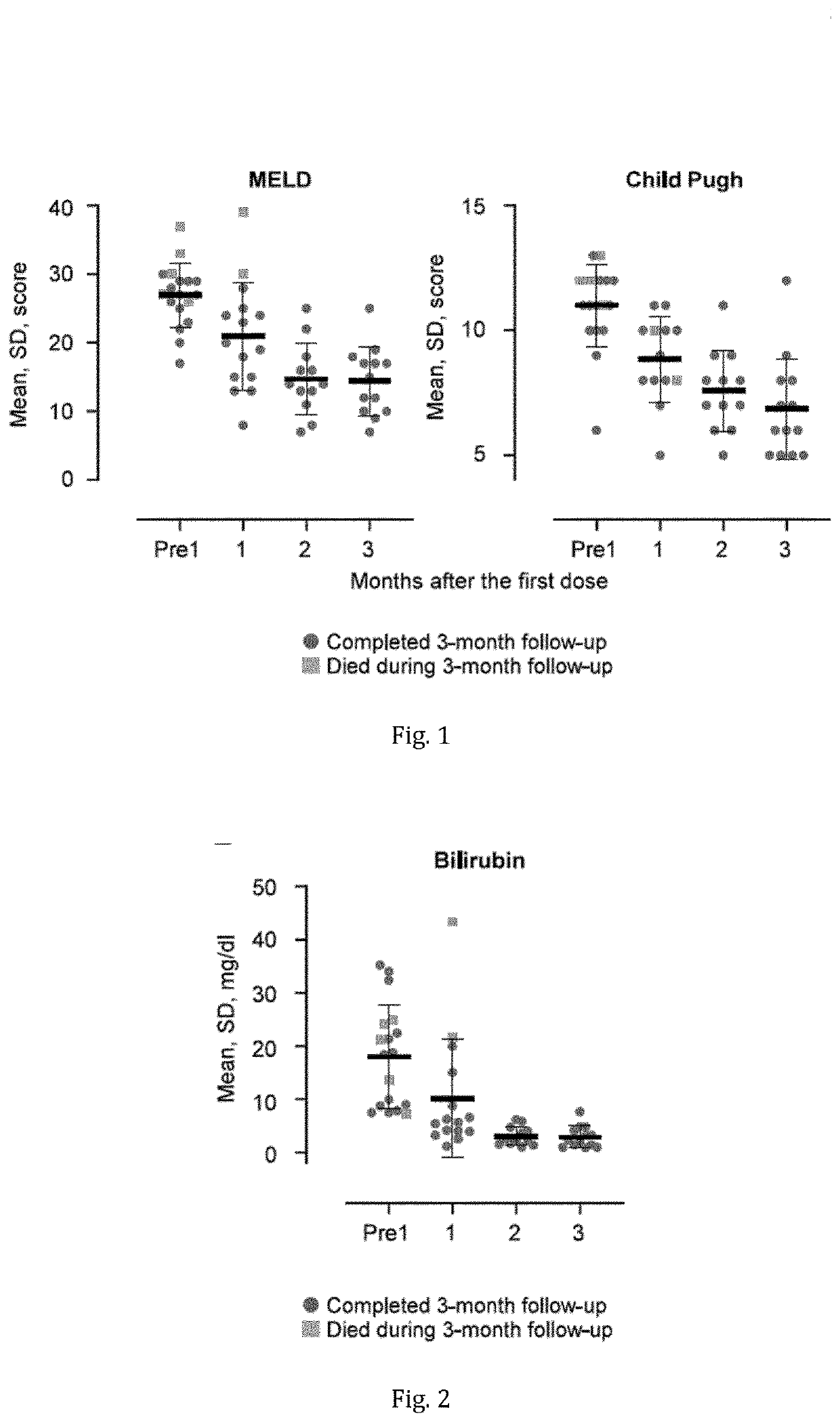Adult Liver Progenitor Cells for Treating Acute-On-Chronic Liver Failure
a liver failure and adult liver technology, applied in the digestive system, inorganic non-active ingredients, pharmaceutical delivery mechanisms, etc., can solve the problems of significant risk of thrombogenesis, achieve high-effective amounts of halpcs, prevent thrombosis or bleeding, and reduce patients' bilirubin levels
- Summary
- Abstract
- Description
- Claims
- Application Information
AI Technical Summary
Benefits of technology
Problems solved by technology
Method used
Image
Examples
example 1
on of HALPCs
[0155]HALPCs were prepared as described in EP 3140393 or WO2017 / 149059 from livers of healthy cadaveric or non-heart beating donors. Briefly, liver cell preparations are re-suspended in Williams' E medium supplemented with 10% FBS, 10 mg / ml INS, 1 mM DEX. The primary cells are cultured on Corning® CellBIND® flasks and cultured at 37° C. in a fully humidified atmosphere containing 5% CO2. After 24 hours, medium is changed in order to eliminate the non-adherent cells and thereafter renewed twice a week, whereas the culture is microscopically followed every day. Culture medium is switched after 12-16 days to high glucose DMEM supplemented with 9% FBS. A cell type with mesenchymal-like morphology emerges and proliferates. When reaching 70-95% confluence, cells are trypsinized with recombinant trypsin and 1 mM EDTA and re-plated at a density of 1-10×103 cells / cm2. At each passage, cells were trypsinized at 80-90% confluency.
[0156]Testing of the cells confirmed that they expre...
example 2
ation of HALPCs to Patients (Interim Results)
[0157]Eight patients with confirmed acute-on-chronic liver failure (ACLF) and seven patients with acute decompensation (AD), with risk of developing ACLF, were treated with HALPCs prepared according to Example 1, using the dosing regimen according the present invention. The cells were counted using the manual method described above. The MELD score of the patients prior to treatment ranged from 18 to 35, with an average of about 27. The total bilirubin serum concentration of each patient was higher than 6 mg / dL (≥100 umol / L); between the patients, it ranged from about 7 to about 43 mg / dL with an average of about 22 mg / dL. All patients received standard medical treatment (SMT) as required by their clinical status, but no concomitant anticoagulant therapy.
[0158]For each administration of HALPCs, a vial with the cells prepared according to Example 1 was thawed and diluted with 45 mL of a sterile liquid carrier which contained a sodium bicarbo...
example 3
ation of HALPCs to Patients (Complete Results)
[0164]The clinical trial of Example 2 was continued until 22 patients in total were subjected to the treatment according to the invention. The cell counts and dosages of the present Example are provided as determined by the automated method described above, using a Nucleocounter NC-200. In summary, the patients were treated as follows:
[0165]One patient received no cells due to a technical issue. Three patients received one infusion of about 0.6 million cells / kg. Three further patients received two infusions of about 0.6 million cells / kg at an interval of about 7 days. Three further patients received one infusion of about 0.8 million cells / kg. Four patients received one infusion with about 1.2 million cells / kg. Eight patients received two infusions of about 1.2 million cells / kg at an interval of about 7 days. In all cases, the infused cells were comprised in compositions that contained only pharmacologically insignificant amounts of hepar...
PUM
 Login to View More
Login to View More Abstract
Description
Claims
Application Information
 Login to View More
Login to View More - R&D
- Intellectual Property
- Life Sciences
- Materials
- Tech Scout
- Unparalleled Data Quality
- Higher Quality Content
- 60% Fewer Hallucinations
Browse by: Latest US Patents, China's latest patents, Technical Efficacy Thesaurus, Application Domain, Technology Topic, Popular Technical Reports.
© 2025 PatSnap. All rights reserved.Legal|Privacy policy|Modern Slavery Act Transparency Statement|Sitemap|About US| Contact US: help@patsnap.com

